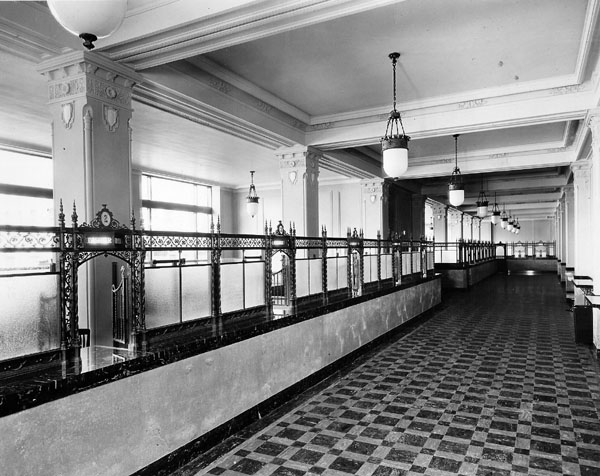
The teller stations on the main floor, reached through the Curtis Street entrance (THG Archives)
931 14th St.
Main Floor
With 45,000 customers in and out of this business office each month in 1929, the Curtis entrance was conveniently designed for customers to pay their bills in person. One hundred and ten employees, known collectively as the Commercial Department, served customers. Six teller cages ran along the north side, with offices and counters available for interviews. Counters extended along the east side for stenographers and order writers. Order checkers’ offices were also on this side. Tellers used a pneumatic tube delivery system to deliver payments to the Commercial Office on the 9th floor. (For an interview with one of the customers who paid his family's phone bill here around the time the building opened, click here
931 Exhibit
Interview with Brownley Guyer
Below is an excerpt from a video interview with Brownley Guyer of Boulder, Colorado. Guyer was born in Denver in 1912, and is asked here about what he remembers about the 931 Building when it was first built. A more complete transcript of the bulk of the interview is below the video. The interviewer is George Howard, THG volunteer from Arvada, Colorado, and the interview took place on June 7, 2006, in the old Presidents' Office in the 931 Building.
Transcript: (BG is the interviewee, Brownley Guyer. GH is George Howard, conducting the interview)
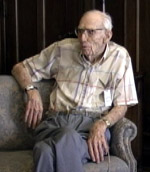 GH: What year were you born in?
GH: What year were you born in?
BG: I was born here in Denver in 1912.
GH: And your dad was born here too, was he not?
BG: My dad was born out here in 1885, out by where the Presbyterian hospital [is]. That used to be called Grasshopper Hill, … and my dad just lived a half a block from it. That’s where he was raised. …
GH: You and your family resided here in Denver for quite a few years.
BG: My grandfather was an early pioneer Denver dentist who came here in 1872. And he was on the school board, … and I just read a book about Emily Griffith Opportunity School … I knew Emily Griffith at Wycliffe before she was murdered, and she told me that my grandfather, he was a dentist here, and he helped Emily Griffith start that Opportunity School ...
GH: When did you leave Denver?
BG: I left Denver in 1937. I was working as a draftsman for the highway department in Silverthorne, at the Loveland Pass road, and I quit that one day and I got married … the next day and I moved to Greeley ...
GH: Now, do you remember this area in downtown?
BG: Yes, I certainly do.
GH: And how did you become acquainted with downtown Denver?
BG: Well, right after we got out of high school, I was fortunate to go to work for a photo engraving company that was run by a friend of my dad’s. And [I] was a delivery boy. And they made these plates for the Paramount theater, and a lot of these places on Curtis St. And you could stand outside here and see all those signs … and they made those plates. So a commercial artist would draw a diagram for the plate, and I would go and pick it up from them and take it back to the engraving office, and then I would deliver it back again. I spent almost three years in downtown Denver delivering and picking up plates and stuff for this company. I worked 5 ½ days a week, and on Saturdays, and I made $10 a week. And then Roosevelt came in and the idea that he would make a minimum wage of $14 a week. That was about from 1931 to 1934.
GH: Where did you go to high school?
BG: I graduated from South High in 1931.
GH: Now where was this business that you had worked for?
BG: 15th and Champa, down where the big courthouse is now.
GH: You had mentioned that you were familiar with a garage that was on the lot where this building is located.
...
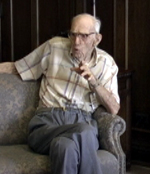 BG: The kid I ran around with, ... his dad had a sign company. His sign company was located on the second floor of this garage. And we used to visit him. His father would get us passes to the theatre because he made signs and things for them, and [we] would get a couple of passes to the show, and we would go down here on Curtis, and the Isis theater I think they called it.
BG: The kid I ran around with, ... his dad had a sign company. His sign company was located on the second floor of this garage. And we used to visit him. His father would get us passes to the theatre because he made signs and things for them, and [we] would get a couple of passes to the show, and we would go down here on Curtis, and the Isis theater I think they called it.
GH: Before you graduated from high school, do you recall this area of the city?
BG: Well yes, I can remember when they built the main city hall ..., that was built in the early '30s.
GH: Now do you remember what was on this particular lot before this building was built?
BG: Well around the corner there was a big white building ..., that was the public service company. I had an uncle that was an electrical engineer. He was in charge of the rates for the public service company. He worked in that building for four years. One of the things I can remember, in the showroom they had a lot of old fashioned washing machines and toasters that they were selling … and next to that there was the …, and I was in the … band for several years … and we’d come down there and practice. And next to that was the old telephone building [1425 Champa Street], and that’s the first telephone building I can remember. And across the street was the Denver dance hall, and I played in that for dances quite a few years. And the fellow that owned it was my neighbor, that’s how I got the job. I watered his lawn once a week, and he always paid me with 15 dimes, I remember that vividly those dimes, and he ran that dance hall for quite a few years.
GH: So there was a phone company building actually next door to this building before this was built?
BG: Yes, it was right up here on Champa St, almost next to the old public service building.
GH: Did you ever go into that old building?
BG: No, I never did. But a friend of mine worked there, a friend of my folks. … and I remember during the Depression I heard that his salary was $250 a month, and how lucky he was that he worked for the telephone company, they were a very well respected company in those days, and you didn’t feel the depression on $250 a month, when you could buy a loaf of bread for 8 cents, with a piece of peppermint candy in the top of it.
GH: What did he do for the telephone company?
BG: I'm not sure … I know one thing he did was go around and collect the nickels from the public telephones …
...
GH: Do you remember when this building was built?
BG: Well, really I don’t. I heard about it … I can remember construction of it, but ... when you’re a kid, you don’t pay attention [to that kind of thing].
…
GH: Why were you across the street?
BG: They had a boy scout merit badge show. Each troop in Denver would select a merit badge that they would want to demonstrate. … My dad always had a first aid booth, he was my scout master.
…
GH: Did your family take the daily paper?
BG: Yes.
GH: Do you remember any stories about the opening of this building?
BG: No, I can’t remember any stories [about it] …
GH: Back in those days, wouldn’t this have been one of the tallest buildings in Denver, if not the tallest?
BG: I would say it was at that time, yes. It’s the biggest building I can remember around here. …
GH: When the building was opened, they held an open house. Do you recall the open house?
BG: No.
GH: What was your first occasion for coming to this building?
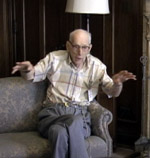 BG: Well I can remember my dad dropping me off and I had a little slip of paper that said I owed the telephone company $3 for half a month, and … I had to run in through the lobby down here. I don’t [know] where I paid it, but it seems like I came in here down the left side and walked in and gave the lady the money and came out with the slip, and my dad was waiting for me double parked.
BG: Well I can remember my dad dropping me off and I had a little slip of paper that said I owed the telephone company $3 for half a month, and … I had to run in through the lobby down here. I don’t [know] where I paid it, but it seems like I came in here down the left side and walked in and gave the lady the money and came out with the slip, and my dad was waiting for me double parked.
GH: Did the clerk stamp that slip?
BG: I can’t remember. It's too long ago. I imagine she marked it paid.
GH: Because you took it home, didn’t you?
BG: I took the slip home, yes.
GH: They took your money, and you took their slip?
BG: Yes, that’s all there was to it, just one little piece of paper.
GH: So far as you can recall, at your home, did your folks have a telephone?
BG: They had a telephone as far back as I can remember. We had no dials in Denver while I lived there.
GH: What did the phone look like?
BG: It was one of those straight phones …
GH: A candlestick?
BG: A candlestick phone, yeah. That's the only kind I can remember we had.
GH: What color was it?
BG: Black.
GH: Do you recall when your family got a dial telephone?
BG: No, because I left home in ’36, … I can’t remember what kind of phone my folks had. I know I used it a lot, but I just don’t remember what it was.
…
GH: How long did your parents reside here in Denver? When were they no longer residents of Denver?
BG: When they died. My father, he died in ’84, [and] my mother died in ’62.
GH: How old was he when he died?
BG: If he’d have lived two weeks he’d have been a hundred years old. My mother was 75.
…
GH: When it comes to Denver, you can’t recall the first dial phones?
BG: Not in Denver. It came here after I left here, in ’36 or ’37. There were no dial phones then.
GH: In your neighborhood?
BG: There was no dial phone at my folks’s.
GH: Would it surprise you to learn that dial phones came with this building?
BG: Yeah, I wouldn’t think about it [coming] with this building.
GH: The original dial equipment came with this building. This building was completed in 1929.
BG: They were a long time getting dial phones into the residents’ houses.
GH: Do you remember, wherever you might have been, any advertising or training for customers of the telephone company so that you found out how the telephone worked?
BG: Yes. I can remember years ago … they had a portable switchboard, and they brought it out to our church one time, and they demonstrated that portable switchboard. It was the first one I ever saw.
…
GH: Do you remember the first dial phone you ever worked with?
BG: Yes, I remember the first one that came into the house.
GH: How did they teach people to use the dial phone?
BG: Oh, I was never taught. I think most of them just kind of figured it out themselves. I know I did. It’s just a matter of common sense, that’s all.
…
GH: Now, we took a tour of the building this morning, didn’t we? What impressed you about this building?
BG: I think the old telephones are interesting, and then the structure of it. I wasn’t aware at the time that they had all those beautiful murals down there. You know, you run in and out of this place, and you never think about it …
GH: What else about the building would you make comment about?
BG: I just like the looks of it, the whole works. And especially since I’ve been in here, I had no idea that this is all what it was …. It is a very, very well built building.
Now, the Curtis St. entrance is locked and is referred to as the “ghost lobby”; it is unused and most of the teller cages are long gone (and the wrought iron around them has been moved to decorate the employee break room on the fifteenth floor).
Sidebar: Operating the Elevators
In 1929, the idea of a fully automated elevator was quite new—so new, in fact, that the elevators in the phone building spooked some visitors, who expected the contraptions to be operated at least partly by hand. The phone company thus hired “elevator operators” to stand and push the buttons.
There was also a public office on this floor serving customers who wished to make long distance or local calls from private booths; this was a separate room, well-furnished with upholstered chairs, “an air cushioned leather sofa, [and] a large library table centered with an Italian pottery vase.” It included private booths and separate rooms equipped with chairs and desks, “where salesmen for national concerns may spend several hours or an entire day calling up their customers.” A library of phone directories was also found on this floor.
In 1929, the idea of a fully automated elevator was quite new—so new, in fact, that the elevators in the phone building spooked some visitors, who expected the contraptions to be operated at least partly by hand. The phone company thus hired “elevator operators” to stand and push the buttons.
The 1,510 employees of the phone company used the entrance on 14th St. (the only entrance open today). Both lobbies were (and are) adorned by magnificent murals painted by Colorado artist Allen True; more about the murals can be found here. Today, the 14th St. lobby is as far as you can get; due to security concerns (since the building is still a working central office owned by Lumen), visitors are not allowed into the building without an escort.
See the panorama below for a view of the 14th St lobby, and the gallery below that for more images of the main floor, from 1929 to 2006.
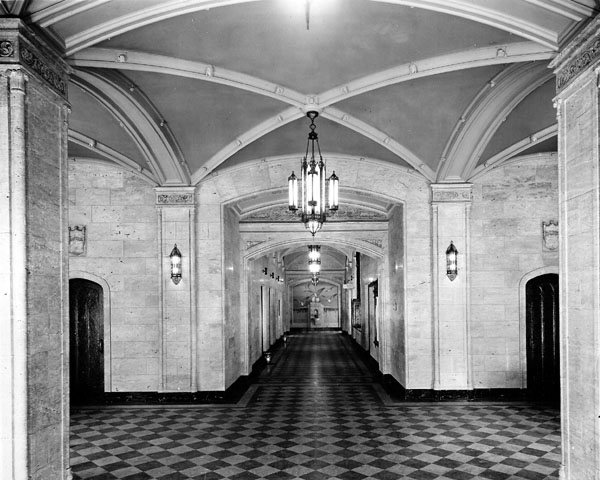
A view of the 14th Street lobby as it was in 1929. Compare this with panorama and the lobby hallway view below.
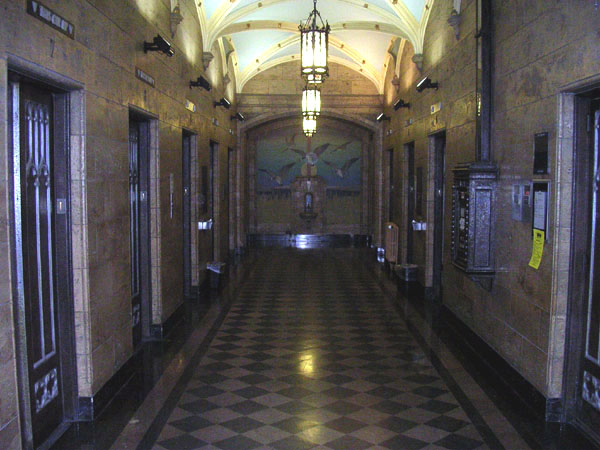
The 14 Street lobby hallway leading past the elevators to the drinking fountain, 2006.
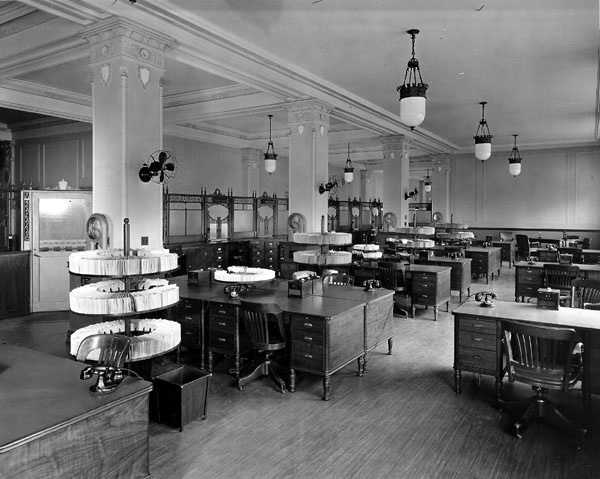
Treasury office, 1929
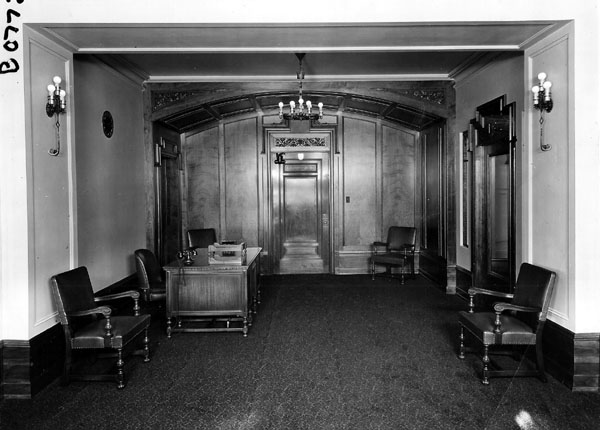
Reception area, 1929
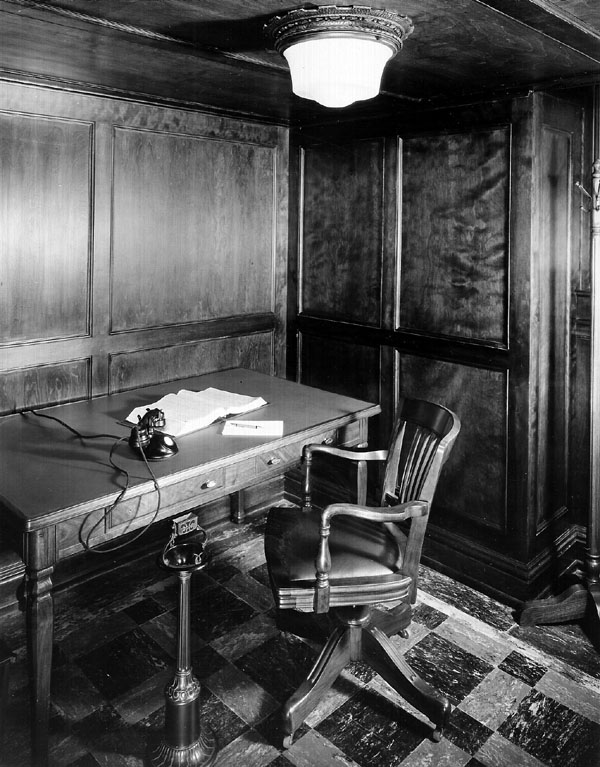
Workspace provided for customer use, 1929
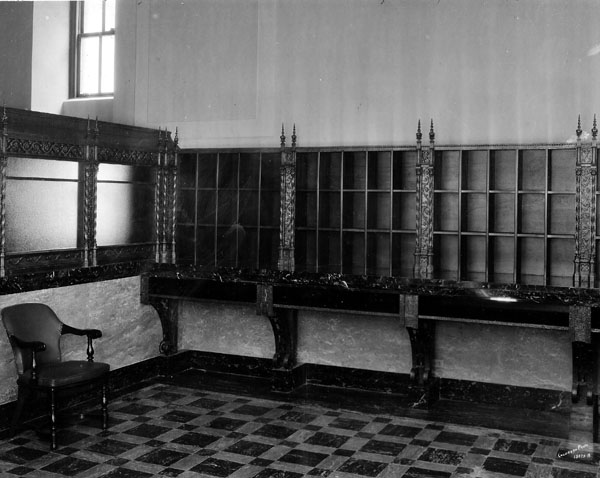
Shelves for non-local telephone directories for customer use, 1929
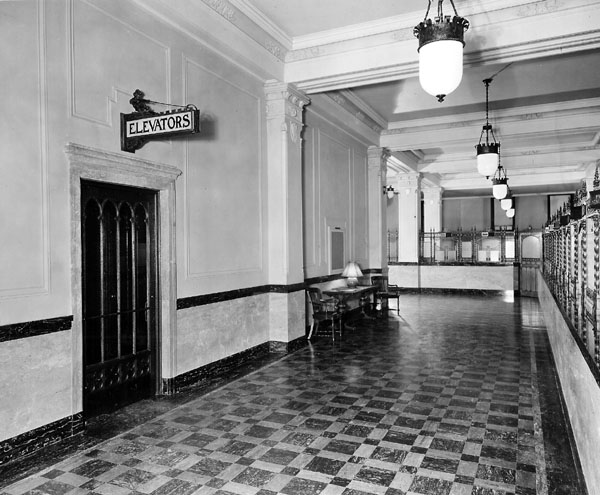
Payment lobby, looking down the hallway, 1929
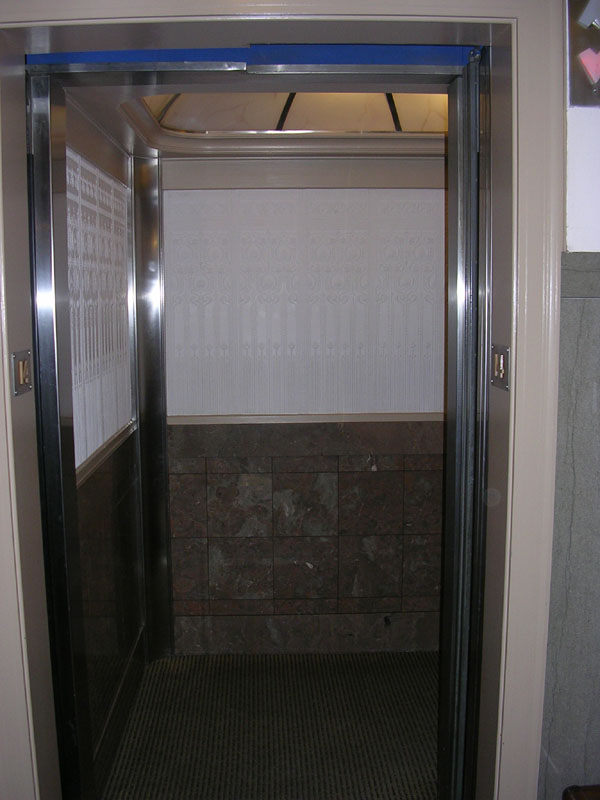
A view of an open elevator, 2006.
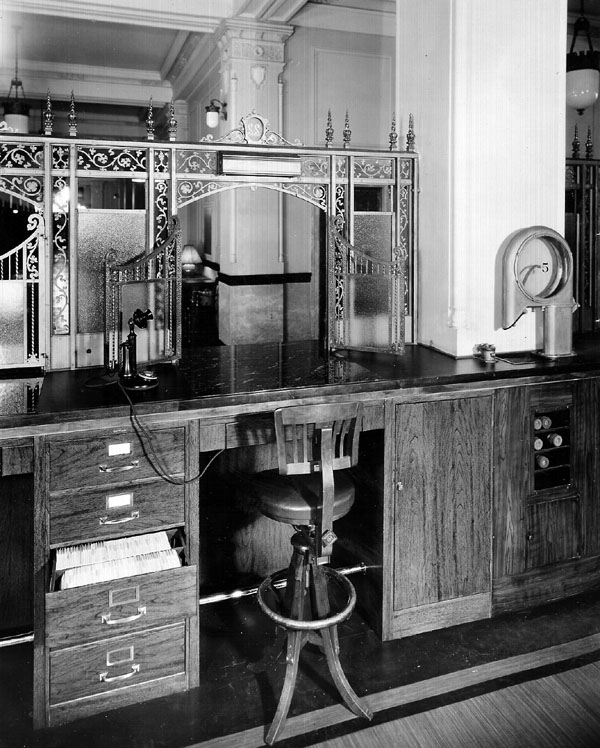
A teller cage from the teller's side, as it was in 1929.
Click here to continue the guided tour up to the even-numbered floors.
Exhibit Entry | Site History | Local Com History | Architecture | True Murals | Building Tour Basements | Main | Even | Odd | 14th Floor | Museum | 15th Floor
931 14th St.
Main Floor

The teller stations on the main floor, reached through the Curtis Street entrance (THG Archives)
With 45,000 customers in and out of this business office each month in 1929, the Curtis entrance was conveniently designed for customers to pay their bills in person. One hundred and ten employees, known collectively as the Commercial Department, served customers. Six teller cages ran along the north side, with offices and counters available for interviews. Counters extended along the east side for stenographers and order writers. Order checkers’ offices were also on this side. Tellers used a pneumatic tube delivery system to deliver payments to the Commercial Office on the 9th floor. (For an interview with one of the customers who paid his family's phone bill here around the time the building opened, click here

931 Exhibit
Interview with Brownley Guyer
Below is an excerpt from a video interview with Brownley Guyer of Boulder, Colorado. Guyer was born in Denver in 1912, and is asked here about what he remembers about the 931 Building when it was first built. A more complete transcript of the bulk of the interview is below the video. The interviewer is George Howard, THG volunteer from Arvada, Colorado, and the interview took place on June 7, 2006, in the old Presidents' Office in the 931 Building.
Transcript: (BG is the interviewee, Brownley Guyer. GH is George Howard, conducting the interview)
 GH: What year were you born in?
GH: What year were you born in?
BG: I was born here in Denver in 1912.
GH: And your dad was born here too, was he not?
BG: My dad was born out here in 1885, out by where the Presbyterian hospital [is]. That used to be called Grasshopper Hill, … and my dad just lived a half a block from it. That’s where he was raised. …
GH: You and your family resided here in Denver for quite a few years.
BG: My grandfather was an early pioneer Denver dentist who came here in 1872. And he was on the school board, … and I just read a book about Emily Griffith Opportunity School … I knew Emily Griffith at Wycliffe before she was murdered, and she told me that my grandfather, he was a dentist here, and he helped Emily Griffith start that Opportunity School ...
GH: When did you leave Denver?
BG: I left Denver in 1937. I was working as a draftsman for the highway department in Silverthorne, at the Loveland Pass road, and I quit that one day and I got married … the next day and I moved to Greeley ...
GH: Now, do you remember this area in downtown?
BG: Yes, I certainly do.
GH: And how did you become acquainted with downtown Denver?
BG: Well, right after we got out of high school, I was fortunate to go to work for a photo engraving company that was run by a friend of my dad’s. And [I] was a delivery boy. And they made these plates for the Paramount theater, and a lot of these places on Curtis St. And you could stand outside here and see all those signs … and they made those plates. So a commercial artist would draw a diagram for the plate, and I would go and pick it up from them and take it back to the engraving office, and then I would deliver it back again. I spent almost three years in downtown Denver delivering and picking up plates and stuff for this company. I worked 5 ½ days a week, and on Saturdays, and I made $10 a week. And then Roosevelt came in and the idea that he would make a minimum wage of $14 a week. That was about from 1931 to 1934.
GH: Where did you go to high school?
BG: I graduated from South High in 1931.
GH: Now where was this business that you had worked for?
BG: 15th and Champa, down where the big courthouse is now.
GH: You had mentioned that you were familiar with a garage that was on the lot where this building is located.
...
 BG: The kid I ran around with, ... his dad had a sign company. His sign company was located on the second floor of this garage. And we used to visit him. His father would get us passes to the theatre because he made signs and things for them, and [we] would get a couple of passes to the show, and we would go down here on Curtis, and the Isis theater I think they called it.
BG: The kid I ran around with, ... his dad had a sign company. His sign company was located on the second floor of this garage. And we used to visit him. His father would get us passes to the theatre because he made signs and things for them, and [we] would get a couple of passes to the show, and we would go down here on Curtis, and the Isis theater I think they called it.
GH: Before you graduated from high school, do you recall this area of the city?
BG: Well yes, I can remember when they built the main city hall ..., that was built in the early '30s.
GH: Now do you remember what was on this particular lot before this building was built?
BG: Well around the corner there was a big white building ..., that was the public service company. I had an uncle that was an electrical engineer. He was in charge of the rates for the public service company. He worked in that building for four years. One of the things I can remember, in the showroom they had a lot of old fashioned washing machines and toasters that they were selling … and next to that there was the …, and I was in the … band for several years … and we’d come down there and practice. And next to that was the old telephone building [1425 Champa Street], and that’s the first telephone building I can remember. And across the street was the Denver dance hall, and I played in that for dances quite a few years. And the fellow that owned it was my neighbor, that’s how I got the job. I watered his lawn once a week, and he always paid me with 15 dimes, I remember that vividly those dimes, and he ran that dance hall for quite a few years.
GH: So there was a phone company building actually next door to this building before this was built?
BG: Yes, it was right up here on Champa St, almost next to the old public service building.
GH: Did you ever go into that old building?
BG: No, I never did. But a friend of mine worked there, a friend of my folks. … and I remember during the Depression I heard that his salary was $250 a month, and how lucky he was that he worked for the telephone company, they were a very well respected company in those days, and you didn’t feel the depression on $250 a month, when you could buy a loaf of bread for 8 cents, with a piece of peppermint candy in the top of it.
GH: What did he do for the telephone company?
BG: I'm not sure … I know one thing he did was go around and collect the nickels from the public telephones …
...
GH: Do you remember when this building was built?
BG: Well, really I don’t. I heard about it … I can remember construction of it, but ... when you’re a kid, you don’t pay attention [to that kind of thing].
…
GH: Why were you across the street?
BG: They had a boy scout merit badge show. Each troop in Denver would select a merit badge that they would want to demonstrate. … My dad always had a first aid booth, he was my scout master.
…
GH: Did your family take the daily paper?
BG: Yes.
GH: Do you remember any stories about the opening of this building?
BG: No, I can’t remember any stories [about it] …
GH: Back in those days, wouldn’t this have been one of the tallest buildings in Denver, if not the tallest?
BG: I would say it was at that time, yes. It’s the biggest building I can remember around here. …
GH: When the building was opened, they held an open house. Do you recall the open house?
BG: No.
GH: What was your first occasion for coming to this building?
 BG: Well I can remember my dad dropping me off and I had a little slip of paper that said I owed the telephone company $3 for half a month, and … I had to run in through the lobby down here. I don’t [know] where I paid it, but it seems like I came in here down the left side and walked in and gave the lady the money and came out with the slip, and my dad was waiting for me double parked.
BG: Well I can remember my dad dropping me off and I had a little slip of paper that said I owed the telephone company $3 for half a month, and … I had to run in through the lobby down here. I don’t [know] where I paid it, but it seems like I came in here down the left side and walked in and gave the lady the money and came out with the slip, and my dad was waiting for me double parked.
GH: Did the clerk stamp that slip?
BG: I can’t remember. It's too long ago. I imagine she marked it paid.
GH: Because you took it home, didn’t you?
BG: I took the slip home, yes.
GH: They took your money, and you took their slip?
BG: Yes, that’s all there was to it, just one little piece of paper.
GH: So far as you can recall, at your home, did your folks have a telephone?
BG: They had a telephone as far back as I can remember. We had no dials in Denver while I lived there.
GH: What did the phone look like?
BG: It was one of those straight phones …
GH: A candlestick?
BG: A candlestick phone, yeah. That's the only kind I can remember we had.
GH: What color was it?
BG: Black.
GH: Do you recall when your family got a dial telephone?
BG: No, because I left home in ’36, … I can’t remember what kind of phone my folks had. I know I used it a lot, but I just don’t remember what it was.
…
GH: How long did your parents reside here in Denver? When were they no longer residents of Denver?
BG: When they died. My father, he died in ’84, [and] my mother died in ’62.
GH: How old was he when he died?
BG: If he’d have lived two weeks he’d have been a hundred years old. My mother was 75.
…
GH: When it comes to Denver, you can’t recall the first dial phones?
BG: Not in Denver. It came here after I left here, in ’36 or ’37. There were no dial phones then.
GH: In your neighborhood?
BG: There was no dial phone at my folks’s.
GH: Would it surprise you to learn that dial phones came with this building?
BG: Yeah, I wouldn’t think about it [coming] with this building.
GH: The original dial equipment came with this building. This building was completed in 1929.
BG: They were a long time getting dial phones into the residents’ houses.
GH: Do you remember, wherever you might have been, any advertising or training for customers of the telephone company so that you found out how the telephone worked?
BG: Yes. I can remember years ago … they had a portable switchboard, and they brought it out to our church one time, and they demonstrated that portable switchboard. It was the first one I ever saw.
…
GH: Do you remember the first dial phone you ever worked with?
BG: Yes, I remember the first one that came into the house.
GH: How did they teach people to use the dial phone?
BG: Oh, I was never taught. I think most of them just kind of figured it out themselves. I know I did. It’s just a matter of common sense, that’s all.
…
GH: Now, we took a tour of the building this morning, didn’t we? What impressed you about this building?
BG: I think the old telephones are interesting, and then the structure of it. I wasn’t aware at the time that they had all those beautiful murals down there. You know, you run in and out of this place, and you never think about it …
GH: What else about the building would you make comment about?
BG: I just like the looks of it, the whole works. And especially since I’ve been in here, I had no idea that this is all what it was …. It is a very, very well built building.
Now, the Curtis St. entrance is locked and is referred to as the “ghost lobby”; it is unused and most of the teller cages are long gone (and the wrought iron around them has been moved to decorate the employee break room on the fifteenth floor).
Sidebar: Operating the Elevators
In 1929, the idea of a fully automated elevator was quite new—so new, in fact, that the elevators in the phone building spooked some visitors, who expected the contraptions to be operated at least partly by hand. The phone company thus hired “elevator operators” to stand and push the buttons.
In 1929, the idea of a fully automated elevator was quite new—so new, in fact, that the elevators in the phone building spooked some visitors, who expected the contraptions to be operated at least partly by hand. The phone company thus hired “elevator operators” to stand and push the buttons.
There was also a public office on this floor serving customers who wished to make long distance or local calls from private booths; this was a separate room, well-furnished with upholstered chairs, “an air cushioned leather sofa, [and] a large library table centered with an Italian pottery vase.” It included private booths and separate rooms equipped with chairs and desks, “where salesmen for national concerns may spend several hours or an entire day calling up their customers.” A library of phone directories was also found on this floor.
The 1,510 employees of the phone company used the entrance on 14th St. (the only entrance open today). Both lobbies were (and are) adorned by magnificent murals painted by Colorado artist Allen True; more about the murals can be found here. Today, the 14th St. lobby is as far as you can get; due to security concerns (since the building is still a working central office owned by Lumen), visitors are not allowed into the building without an escort.
See the gallery below that for more images of the main floor, from 1929 to 2006.

A view of the 14th Street lobby as it was in 1929. Compare this with the lobby hallway view below.

The 14 Street lobby hallway leading past the elevators to the drinking fountain, 2006.

Treasury office, 1929

Reception area, 1929

Workspace provided for customer use, 1929

Shelves for non-local telephone directories for customer use, 1929

Payment lobby, looking down the hallway, 1929

A view of an open elevator, 2006.

A teller cage from the teller's side, as it was in 1929.
Click here to continue the guided tour up to the even-numbered floors.
back to top
back to Basements
climb to Even Floors
Exhibit Entry | Site History | Local Com History | Architecture | True Murals | Building Tour
Basements | Main | Even | Odd | 14th Floor | Museum | 15th Floor